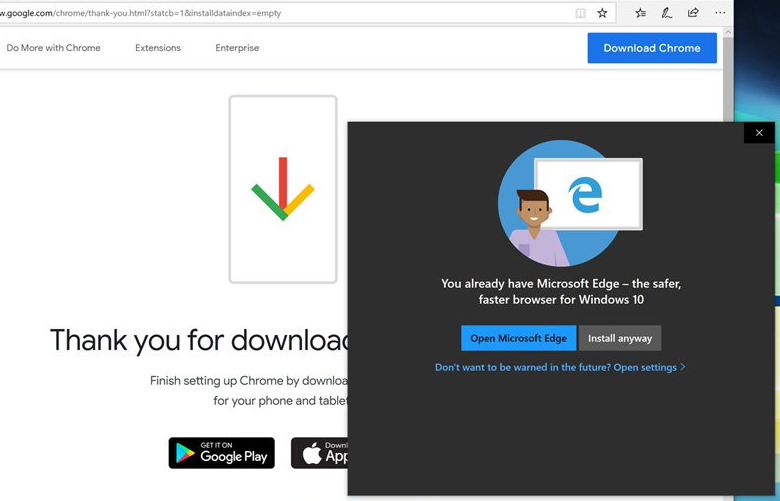Interception of the installation of Firefox and Chrome in Windows 10

Screenshot thurrott.com
The insider assembly of Windows 10 v.1809 has a new feature . When a user tries to install Firefox or Chrome, the system now shows a message that the computer already has Microsoft Edge - and offers to launch this “faster and safer browser”.
The OS intercepts the installation of an alternative software that is not approved for installation, and tries to discourage the user from unwanted actions.
In addition, in the last build, the settings for applications have changed. Previously, the default was to install any program - Allow apps from anywhere (Default) . The other options offered were "Warn about installing applications not from the Store" and "Allow installation of applications only from the Store."
')
The new default setting is “Show recommendations for apps” ( Show me app recomendations ). Other options are “Disable recommendations for applications”, “Warn about installing non-Store applications” and “Allow installation of applications only from the Store”.

Screenshot thurrott.com
Apparently, the interception of the installation of Firefox and Chrome in Windows 10 takes place in accordance with the new default settings in the Apps & features section, that is, “Show recommendations for applications”. Recommendations in Windows 10 include warnings about installing "unnecessary" browsers, such as Firefox and Chrome.
The emergence of this function has caused outrage among some users. Many people still remember the annoying offers to install Windows 10, which were displayed in Windows 7. Refusing these offers was a nontrivial task, so sometimes the installation of Windows 10 started against the user's wishes.
According to commentators, such actions indicate an increase in the struggle in the browser market and the desire of Microsoft to maintain / increase its share. Chrome is now dominant in this market, including thanks to Google’s aggressive policy of advertising this browser on its websites. Many Firefox and Edge users have probably met offers to install Chrome on sites that belong to Google. There are other methods: for example, the recent YouTube redesign uses the exotic Shadow DOM v0 API, which is implemented only in Chrome. As a result, YouTube pages load faster in Chrome than in other browsers .
In addition, Chrome may "accidentally" become the default browser during the installation of some extraneous free utility. This practice is so common that there are even special tools that remove all unnecessary checkboxes during the installation of any programs.
Apple is also trying to offer MacOS users its Safari browser. Unlike competitors, Firefox does not advance in such ways: Mozilla does not have at its disposal a platform for such promotion.
It is not yet known whether the new function will come in with the interception of the installation of alternative browsers in the big October 10 update of Windows 10. If this happens, such actions may cause opposition from the EU antitrust committee. Considering the experience of past antitrust processes in the EU, Microsoft can target the display of such Edge browser recommendations for users outside the EU to avoid problems.
"Recommendations for applications" in Windows 10 may indeed be useful to some users. For example, many do not know that in order to view PDF files, it is not necessary to install Acrobat Reader and, thus, add new potential vulnerabilities to the system. That is, Microsoft quite reasonably enabled this option by default. The question is only in the content of the recommendations themselves.

Source: https://habr.com/ru/post/423511/
All Articles